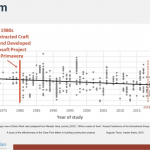If Disney can turn a century of Princesses being rescued from death, debauchery, and an uncertain future by a Prince into a modern-day manifesto for female empowerment, then certainly the construction industry should be able to overhaul its image and reality, to reflect the cultural identity and changing societal norms of our time. This utopian version might have a merit-based system of pay rather than an equity-based one, do away with gender-biased norms, and usher in a new era where minds win out over muscle. In this new reality, we will be strapped into the roller coaster, climbing the tracks of the fourth industrial revolution, the winds of galactic digital change blowing all around us. It’s an adrenaline-pumping thrill that teeters on the edge of fear of the unknown will propel us to new heights and ways of working. This new world will do away with many aspects of our construction existence that will require manual labor, specifically for those tasks that eat up time. They will be mechanized, roboticized, and automated, removing the need for human labor in those instances but not removing the need for human ingenuity within the industry. Jobs will change, and the individuals that fill them will look different than generations past.
The good news is history repeats itself. The bad news is that history repeats itself. We’ve been through three industrial revolutions before. Well, not you and I, but mankind. Revolution 1 (R1), stone to metal; R2, wind to steam; R3 steam to electricity; and now R4 will open the door on information technology and the digitization of, well, just about everything. The difference between the revolutions of the past and R4 is not only the reduction and/or elimination of manual labor for many of the tasks that take place in the field or in manufacturing facilities but in the significant shortage of workers. The prick of pain we’ve felt during the pandemic around labor is going to feel like a prizefighter’s right hook pummeling us over the next eight or nine years as 41% of our industry retires out and as the interest in pursuing a career in the trades and construction in general dwindles.
If you’re wondering where the good news in this story lies, it’s in the potential for significant change. Gone will go the derogatory remarks and the tests designed to prove superior brawn. Like Disney’s eradication and sanitization of Cinderella’s story, we’ll wipe clean from the slate our own Grimm’s version of the sexualized workplace interaction and replace it with a reverence for problem-solving prowess, measured risk-taking tactics, and analytical insights, which will lead to a safer, more efficient, and revolutionized construction process. We will care less about gender and more about forming teams that align with the values of an organization. The companies that will survive and thrive in this new world will be those that self-publish their goals and aspirations and then go about the business of doing the hard work of putting their words into action.
While we number few, we women in construction, are mighty. Our challenges are not so different than those of other industries, but the reasons for pursuing construction as a woman are formidable – the wage gap between men and women is only 5%, a gap that many companies have self-selected into being held accountable for closing, making us well paid, and at higher rates than pink-collar professions, and we have our own version of turning pumpkins into carriages. Those conversions do indeed change the lives of the people that live, work, or visit the buildings we played a role in bringing about. I have a very good feeling this story is going to have a happy ending.










